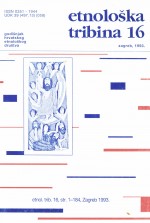Predenje bez preslice u sjeverozapadnoj Hrvatskoj
Spinning Without Distaff in Northwestern Croatia
Author(s): Jelka Radauš RibarićSubject(s): Gender Studies, Customs / Folklore, Cultural Anthropology / Ethnology, Post-War period (1950 - 1989)
Published by: Hrvatsko etnološko društvo
Keywords: spinning; Northwestern Croatia; tradition; anthropology; woman;
Summary/Abstract: The author presents data that she gathered in 1965 in northwestern Croatia, in the territory watered by the river Kupa and its affluents Dobra, Mrežnica, and Korana, all the way to the river Kupčina and the southern slopes of Jaskansko prigorje and Vukomeričke gorice. In this area women were spinning until after the World War II in a very archaic manner. They used a spindle but not a distaff. They fixed the vegetable fiber, mostly flax, to the head and spun yam from the flax using the left hand, disentangling it with fingers and teeth, spitting on it, and then passing it on to the spindle which they held in the right hand. While doing this they spat any impurity found in flax. In this way of spinning lips form the thread, saliva moistens vegetable fiber, and teeth are an important element for without them a woman cannot make a thin and smooth thread. That is why those women who had lost their front teeth had to spin with a distaff. They stuck it in the bench or in the bed. They had to sit while working, they worked at night but needed light because they had to see whether the thread was flat On the contrary, without a distaff they could spin outside the house, even in the dark, because they could feel the smoothness of the thread among lips. Based on many fieldwork examples it is established that spinning from the head (od glave) is found only among autochtonous Croats in that area, while new Croatian and Serbian inhabitants, who after Turkish raids into Balkan peninsula settled this area between 15th and 17th centuries, do not know it. The conclusion that this way of spinning is a heritage of Croats from the time of their migration to the South in the 7th century is substantiated by comparative data from Slovakia and Bohemia, Germany and Scandinavia. Spinning from the head in this part of Croatia preserves in detail an elementary way of getting thread and we could hypothesize that it is a neolithic technological process of the European continent, pertaining especially to its northwestern part.
Journal: Etnološka tribina : Godišnjak Hrvatskog etnološkog društva
- Issue Year: 23/1993
- Issue No: 16
- Page Range: 147-164
- Page Count: 18
- Language: Croatian

